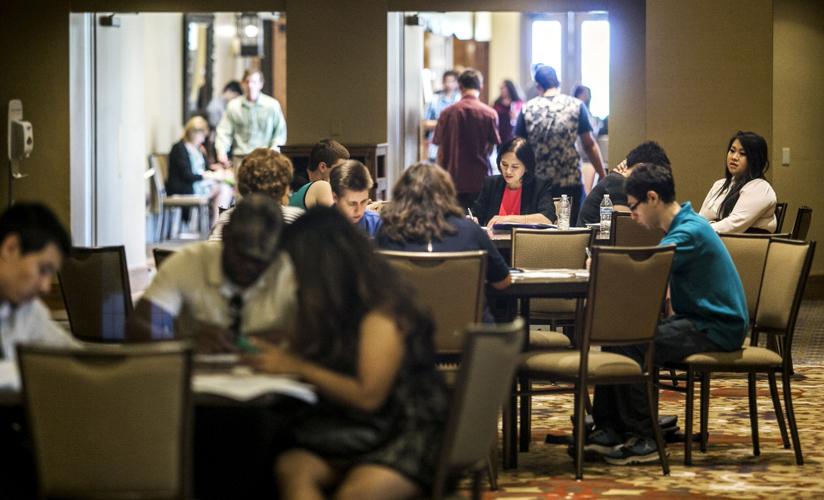Two main meanings of “growth” used to be entangled in Tucson’s vocabulary.
For decades, population growth here drove economic growth, so they were treated as one thing called, simply, “growth.” Some people supported growth because it meant prosperity; others opposed it because it meant urban sprawl.
On Friday, it became clearer than ever that in Tucson, those two meanings are finally becoming disentangled. At UA economist George Hammond‘s annual economic forecast event, he said the metro area’s population growth hit 1.1 percent in 2014 and isn’t likely to hit 1 percent for the next three years.
Contrast that with the Tucson area’s average annual population growth from 1977 to 2007 — 2.4 percent.
“We’re going to add jobs and may add some population, but we’re not going back to the growth we had in the 30 years before the Great Recession,” Hammond said.
In other words, population growth won’t be driving our economic growth, the way it always has.
You could call that unmitigated bad news. And, if you’re in an industry like homebuilding, you probably will. But there is a flip-side to the story.
While Tucson has depended on population growth to power its economy for decades, for almost as long, public officials, economists and others have been trying to get us out of our dependence on population growth to drive economic growth.
On Monday, I asked David Taylor, a retired city planner well known for his insights on Tucson’s growth, how long people have been pointing to the need for Tucson to find an alternative economic formula. He pointed to Roy Drachman‘s effort to establish a “Tucson Regional Plan” in 1938.
When I covered business news and was the Star’s business editor from 2003-2009, I regularly heard of our need to diversify our economy beyond population-growth-dependent industries like homebuilding.
In December 2003, the first year I covered one of the UA Eller School’s annual economic forecasts, economist Marshall Vest told the crowd population growth was driving Tucson’s economy, with big increases in leisure and hospitality jobs. But he warned, “What we really need is to identify new-economy type industries.”
By early 2009, as the recession took hold, Vest said of Tucson’s past decade, “The economy was powered by the growth in population and the flow of money into real estate. That’s not a good driver of the economy, because it usually ends badly, as we’re seeing.”
At the same time, Joe Snell, president then and now of our regional economic-development agency, said of population growth, “We’re hooked on a drug right now. We’re going to have to go through detox.”
Guess what? Voluntarily or not, we’ve been going through detox.
The story isn’t the same in Maricopa County. The Phoenix area grew incredibly fast from 1977 to 2007 — about 3.6 percent per year. Although Arizona’s main metro was also hit hard by the recession, this year its population growth rate was 1.8 percent. Economists expect that to accelerate.
With our two cities’ populations growing at such remarkably different rates over the years, the Tucson metro area’s share of state population — and therefore our influence in the state — has dropped. In 1990, the Phoenix area accounted for 61 percent of the state’s population; now it has about 66 percent. Over that same 25-year period, the Tucson area’s share of state population dropped from 18 to 15 percent.
The good news is, we’ve known for years we have to flip the equation. Rather than having population growth be the main driver of economic growth, we need strong economic growth to drive population growth.
That latter dynamic is most easily visible in boomtowns like Williston, N.D., where the oil industry’s growth has caused population to soar. But it’s also visible in well-known engines like San Jose, California, and Seattle. Their tech industries have created vibrant economies that have driven population growth.
It’s been a tough adjustment. But at least, having known what we needed to do for so long, the path forward comes as no surprise. We’ve had no lack of well-considered visions, blueprints and plans in the Tucson area, most of them with similar conclusions. Some of the common recommendations have been:
- Improving education in all aspects — K-12 schools, job training, college and beyond.
- Facilitating high-tech businesses such as those in our existing optics and biomedical sectors.
- Increasing trade with Mexico and developing our interstate logistics businesses.
- Upgrading the quality of life here for both visitors and residents, with better roads, parks and attractions.
We’ve made starts down these paths. Now that our dependable economic safety net — population growth — has shredded, the only thing we can do is keep going.
If our economy finally does ignite, the population will follow, and we can tangle up those meanings of “growth” once again.






